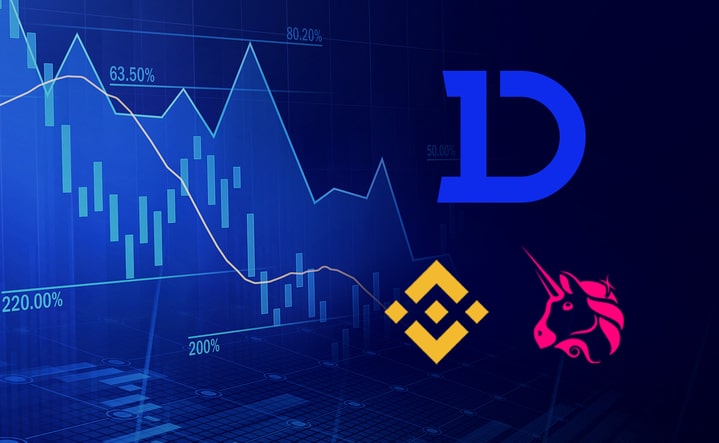In recent years, decentralized exchanges (DEXs) have emerged as a viable alternative to centralized exchanges (CEXs) in the world of cryptocurrency trading. The transaction volume on DEXs has been steadily growing, reaching $224 billion from April 2021 to April 2022, surpassing that of centralized exchanges, which recorded $175 billion in the same period. This marks a significant shift, considering that Chainalysis reported that over 90% of cryptocurrency transactions were conducted on centralized exchanges in the first half of 2021.
So why the sudden rise of decentralized exchanges? One of the main reasons is the transparency they offer, which is lacking in traditional exchanges. Moreover, after several high-profile bankruptcies of centralized exchanges like Celsius and FTX, users are increasingly wary of the lack of regulation and transparency in the industry.
As awareness of the risk that “customers cannot transparently verify their held assets” with centralized exchanges increases, more users are opting for decentralized exchanges as an alternative. However, decentralized exchanges still fall short of being a perfect alternative for users. This is mainly due to the persistent problem of “gas fees” associated with decentralized exchanges. Unlike centralized exchanges, decentralized exchanges operate on the blockchain, which means that gas fees are incurred for each transaction. For users accustomed to trading without gas fees on centralized exchanges, this can be a significant obstacle.
Even Binance and Uniswap could not solve this problem
Binance remains the top preference for cryptocurrency traders due to its convenient trading services, user-friendly interface, and diverse range of trading pairs. According to CoinMarketCap, it has recorded a trading volume of over $17 billion in the last 24 hours, surpassing popular exchanges like Coinbase and Kraken.
However, transparency concerning customers’ assets remains a challenge. Although Binance conducts regular “Proof of Reserves” audits to prove that it holds sufficient reserves to cover all user balances, concerns have been raised about the company’s debt exceeding its assets based on its previously disclosed reserve proof report.
Due to the system of centralized exchanges, customers’ transaction histories are not transparently disclosed, and as a result, concerns about the “safety of funds” for users have not been completely addressed. Entrusting assets to a third party is the main drawback of centralized exchanges, which not only contradicts the fundamental principles of cryptocurrencies and blockchain technology but also makes it vulnerable to hacking or cyber attacks since all assets are managed in one place. Additionally, the complex KYC (Know Your Customer) process is also considered a major drawback.
Can Decentralized exchanges solve this?
Looking at the popular decentralized exchange, Uniswap, it allows users to directly trade on the blockchain using their personal wallets without the need for a complex KYC (Know Your Customer) process. This gives users complete control and transparency over the storage and management of their funds, as well as easy access to information about their assets. However, as all transactions are recorded on the blockchain, each transaction incurs a gas fee, which can be a significant disadvantage for users who frequently trade. Additionally, the lack of freedom from gas fees limits the types of supported trading services, leading to lower overall liquidity compared to centralized exchanges. Furthermore, the user interface without an order book differs significantly from centralized exchanges, making it more difficult for existing centralized exchanges users to navigate.
How INNODEX offers best of the both worlds?
INNODEX operates like a traditional DEX, enabling users to store and trade their assets directly from their personal wallets without complicated KYC procedures. This ensures that users retain full control over their funds, and the transparency of the blockchain allows for easy monitoring of their holdings. However, INNODEX’s key innovation lies in its ability to eliminate the high gas fees associated with each transaction on a DEX. Instead, a single gas fee is charged daily when the user’s wallet is synced with the blockchain, with no additional fees charged for subsequent trades.
But that’s not all – INNODEX also offers a range of features that will be familiar to CEX users, such as a comprehensive order book and multiple order types including market orders. This makes it more accessible to users who are used to trading on centralized platforms, without sacrificing the benefits of decentralization.
With INNODEX leading the way, it’s clear that DEXs have come a long way in addressing the limitations of traditional exchanges while retaining the key advantages of blockchain technology. By offering a more user-friendly and cost-effective way to trade, they are poised to become the preferred platform for crypto traders around the world.
The INNODEX platform, powered by NvirWorld’s “Stay Pending” technology, could prove to be a game-changer in decentralized exchanges. It reduces gas fees for users and maximizes convenience, lowering the entry barrier for decentralized exchanges to secure abundant liquidity and provide a variety of trading services close to centralized exchanges. NvirWorld is also developing and providing various other patented technologies to commercialize blockchain technology. One of the patented technologies is allowing users to make payment and transactions using cryptocurrencies even during network blockages, and this technology is being introduced into the mainnet scheduled to be launched in the fourth quarter.
Moreover, NvirWorld has official partnerships with industry experts Solana and ConsenSys, and has launched the deflationary coin “NVIR,” which is gaining attention as having potential comparable to Ethereum as a blockchain project.
With INNODEX, there is no need to make regretful choices between centralized and decentralized exchanges, as it absorbs only their advantages and eliminates their disadvantages.
The platform is currently undergoing the 4th closed beta test and continuously developing user-friendly additional services, such as the email login function and Google Authentication for 2-factor authentication. INNODEX is expected to open up new horizons in the cryptocurrency market, ushering in huge perceptual changes that will shape the future.

